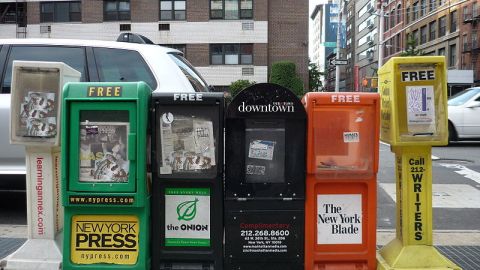Why Don’t Newspapers Make Any Money?

Newspapers around the country have begun to fold. The Rocky Mountain News closed in February of last year after 150 years of operation. Some papers, like the Seattle Post-Intelligencer, have stayed afloat by discontinuing their print editions entirely. Other venerable local papers like The Boston Globe and The San Francisco Chronicle have come close to insolvency and talked of shutting down. Newsrooms everywhere are laying off staff and closing bureaus. They just aren’t making enough money to pay the bills.
As I wrote yesterday, local papers used to be central clearinghouses of useful information. But with the rise of radio, television, and now the Internet, people have increasingly turned to other sources for what they used to be able to get only from their local paper. As a result circulation began to fall in the 1990s and really collapsed in the last five years. Fewer readers means subscription and ad revenue have fallen dramatically. Ad revenue in the U.S. is down 10% over the first quarter of last year, and has been down compared with the previous year for the last 13 quarters. Newspapers have responded by slashing costs, eliminating content, and increasing subscription prices. But they can’t continue to cut out content and raise prices forever. These are stopgap solutions that only delay the inevitable.
Newspapers have been hit particularly hard by the migration of classified ads to specialized online sites like Craigslist and Monster.com. There used to be a natural synergy between news and classified advertising. It made sense to post your ads in the same paper that everyone got to read the news. But the growth of the Internet has made newspapers’ subscriber base much less valuable. In a sense, the Internet is already like a virtual paper that everyone subscribes to. Now, if anything, there is an advantage to posting your ads on websites that specialize in job listings, or car sales, or personals. That has led to the “unbundling” of news and classified advertising. Newspapers are now in danger of losing their classifed ad revenue—which traditionally accounted for some 30-40% of newspaper revenue—entirely. As Google’s Josh Cohen told James Fallows, that is by itself enough to explain what’s happened to newspapers: “In any business, if you lose a third of your revenue, you’re going to be in serious trouble.”
It simply no longer makes sense to produce the same package of news, features, and classified ads as it once did. The old business model is destined for the ash heap of history. But that doesn’t mean that journalism itself is dead. Newspapers may no longer have an advantage in the classified advertising business, but they are still experts in reporting the news. That expertise is worth money. They can’t continue to give the news away cheaply to subscribers or online as a way of attracted readers to a classified advertising business that no longer exists, however. They have to find a new business model—a new way to get paid—for what is ultimately their core business. As I’ll explain in my next post, they have to find a way of making money off their reporting itself.





